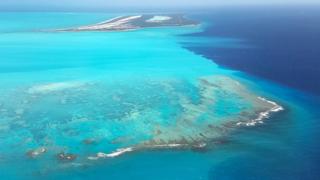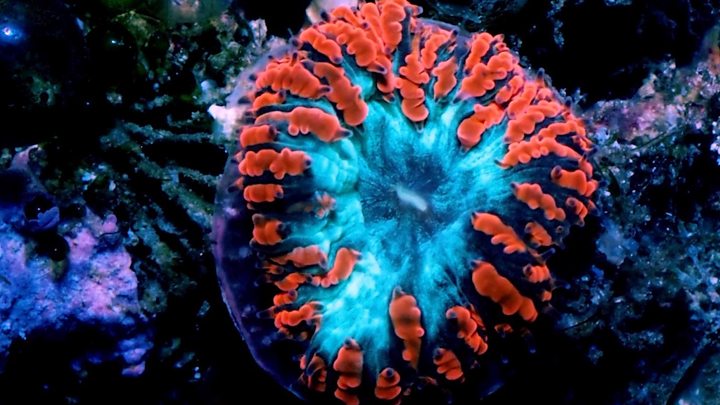This website uses cookies so that we can provide you with the best user experience possible. Cookie information is stored in your browser and performs functions such as recognising you when you return to our website and helping our team to understand which sections of the website you find most interesting and useful.
 Image copyright Kandi Hariraj
Image copyright Kandi HarirajFrom the air, the turquoise hues of the Turks and Caicos Islands' vast barrier reef appear as an expanse of blistering beauty.
One of the largest reef systems on Earth, it teems with wildlife like friendly wild dolphins, and attracts more than a million tourists a year.
But underneath the water's stunning surface lurks a deadly disease, silently ravaging the corals which keep its denizens alive and protect the islands' pristine coastline from storms and erosion.
Stony coral tissue loss disease (SCTLD) has been dubbed the biggest threat facing the tiny British territory's marine environment, and the most virulent coral sickness the world has ever seen.
'Not coming back'
"This is a serious problem, if not a crisis," says Don Stark of local NGO the TC Reef Fund (TCRF). "We've already lost many coral heads - and they're not coming back."
It is not just these islands, 600 miles (965km) south-east of Miami, that are affected.
Since the disease first appeared off the Floridian coast in 2014, where it has now impacted 100,000 acres (40,500ha), it has made its way through the Caribbean into several countries including Jamaica, Belize, the US Virgin Islands and the Dominican Republic.
You may also be interested in:
Its rapid-fire spread and high mortality rate have seen it wipe out some of the region's most important reef-building corals, sparking additional fears for tourism and those who rely on the ocean for a living.
Exacerbating concerns in Turks and Caicos is a long wait for the local government to grant the TCRF permission to begin intervention work.
More than 1,200 people recently signed a petition demanding the group be given the go-ahead to start administering antibiotics, a process which has seen success in Florida.
Mr Stark says the NGO has had equipment on the ground since September. The absence of a permit means it is powerless to do anything but "watch corals die".
Meanwhile, the disease has spread to four islands across the Turks and Caicos archipelago.
The disease is treatable but treatments are labour intensive, Mr Stark says. Urgent action is vital to "save the country's reefs from devastation before the damage is irreversible", he adds.
For its part, the government says it is "seriously weighing the best course of action". A spokesman said authorities were consulting international experts on the ramifications of putting antibiotics in the water.
'Potential disaster'
Scientists are still uncertain about the disease's exact cause, but it is thought to be due to bacteria, passed to other corals through direct contact and water circulation. Some suggest bilge water from passing freighters could be aggravating its spread in Turks and Caicos.
The malady typically appears as small patches of white exposed skeleton and is recognisable by its breakneck contagion, usually killing corals within weeks of them becoming infected.
"It's a potential disaster," says TCRF's Alizee Zimmermann, who first spotted the ailment last year.
"My immediate thought was: something is wrong, the reef is sick. I could see live tissue peeling off. We don't know how it's being transmitted specifically, which makes it incredibly difficult to assess," she explains.
"It wasn't treated in Florida for some time because no-one knew what it was, and they've lost a huge percentage of their reef. But if the right measures are taken in a timely manner, we have a really good chance of slowing it down while scientists figure it out," Ms Zimmermann adds.
Karen Neely of Florida's Nova Southeastern University, which has been studying the disease, says it is "unprecedented" in terms of its reach and the number of coral species affected.
"Infection and mortality rates are extremely high. This disease moves quickly and can rapidly decimate reefs. In impacted regions, it has significantly changed coral cover, species composition, and ecosystem function," Ms Neely adds.
SCTLD poses additional concerns because it attacks many threatened species, such as the Caribbean's iconic but rare pillar coral, explains Judith Lang of the Atlantic and Gulf Rapid Reef Assessment (AGRRA) programme.
While certain coral varieties appear immune, the disease affects more than 20 others, some of which have taken centuries to grow.
Winter threat
Warmer waters associated with summer - and a trigger for coral bleaching - unexpectedly appeared to slow down SCTLD's spread in Florida, a pattern mirrored in the Turks and Caicos.
Now temperatures have dipped again, contagion appears to be picking up speed, TCRF chiefs say. They fear they face a race against time to save the reef, widely considered one of the healthiest in the Caribbean.
Dive instructor and naturalist Lee Munson moved to the territory in 2012, seduced by its unspoilt environment.
While turtles, dolphins and vibrant fish still thrive, its waters are already under increasing pressure from pollutants and climate change-related warming, he warns.
"This disease is the new kid on the block and it's a big concern. We do everything we can, like sterilising dive equipment religiously so we don't spread it," he says.
"But if the reef becomes unhealthy and dull, then people will go elsewhere."
Mr Munson adds: "This is not like bleaching, which coral can recover from. It's final; once it's gone, it's gone."
You may want to watch:

Media playback is unsupported on your device



 Africana55 Radio
Africana55 Radio 
